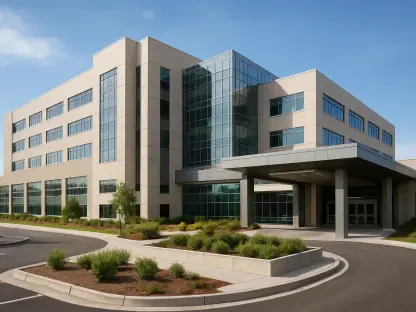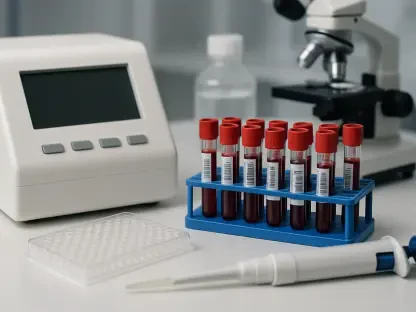In an era where healthcare is undergoing a profound digital transformation, the Remote Patient Monitoring (RPM) market stands out as a pivotal force reshaping how care is delivered across the globe. A recent comprehensive report highlights that this market, valued at $6.17 billion in 2024, is on a trajectory to grow exponentially, reaching a staggering $30 billion by 2035. This remarkable expansion, driven by a compound annual growth rate (CAGR) of 15.5% from 2025 to 2035, signals a fundamental shift toward telehealth and connected health solutions. RPM empowers healthcare providers to track patients’ conditions remotely using advanced digital tools, ensuring better health outcomes while significantly reducing costs. The technology not only bridges geographical barriers but also addresses some of the most pressing challenges in modern healthcare, such as accessibility and resource optimization. As the world grapples with an aging population and a surge in chronic illnesses, RPM emerges as a critical solution, promising to redefine patient care outside traditional clinical environments.
Forces Behind Market Expansion
The meteoric rise of the RPM market is fueled by a confluence of powerful factors that address both systemic and individual healthcare needs. One of the primary drivers is the growing adoption of telehealth, which allows medical professionals to extend their reach far beyond hospital walls. Patients in rural or underserved areas can now receive consistent care without the burden of frequent travel, a development that is particularly vital for those managing chronic conditions like diabetes or hypertension. By enabling continuous health tracking, RPM helps prevent severe complications and reduces the likelihood of costly hospital readmissions. This shift toward remote care also aligns with broader industry goals of improving efficiency, as it frees up valuable resources in overburdened healthcare systems while maintaining high standards of patient engagement and treatment quality.
Another significant catalyst for RPM’s growth is the urgent need for cost-effective healthcare models amid rising global medical expenditures. With chronic diseases placing an immense financial strain on both individuals and institutions, RPM offers a sustainable alternative by minimizing unnecessary clinical visits and optimizing care delivery. Government initiatives across various regions further bolster this trend, with policies and funding aimed at integrating digital health solutions into mainstream systems. These supportive frameworks, combined with increasing public awareness of telehealth benefits, create fertile ground for RPM to thrive. The market’s trajectory reflects a broader recognition that remote monitoring is not just a temporary fix but a long-term strategy to address systemic inefficiencies in healthcare delivery.
Technological Breakthroughs Fueling Growth
At the heart of RPM’s rapid advancement lies a wave of technological innovation that has made remote care more precise, accessible, and scalable. Wearable devices, such as smartwatches and fitness trackers, alongside Internet of Things (IoT)-enabled tools, have revolutionized how health data is collected and analyzed. These gadgets provide real-time insights into vital signs like heart rate and blood pressure, empowering patients to take an active role in managing their health while giving providers critical information to act swiftly when needed. The seamless integration of mobile health applications further enhances user-friendliness, ensuring that even those less tech-savvy can benefit from RPM solutions. This technological ecosystem is reshaping the patient-provider dynamic, fostering a more proactive approach to healthcare.
Beyond wearables, the incorporation of artificial intelligence (AI) and predictive analytics into RPM platforms marks a significant leap forward. These advanced tools can identify potential health risks before they escalate, enabling early interventions that save lives and reduce costs. Additionally, the shift toward cloud-based systems offers unparalleled scalability and flexibility compared to traditional on-premises setups, making RPM accessible to a wider range of healthcare facilities, from large hospitals to small clinics. Innovations like 5G connectivity also play a crucial role by ensuring real-time data transmission, even in remote areas with limited infrastructure. Together, these advancements position RPM as an indispensable component of modern healthcare, capable of addressing complex challenges with cutting-edge solutions.
Diverse Applications and Stakeholders
The scope of RPM extends across a wide array of applications, making it a versatile tool in addressing varied healthcare needs. From chronic disease management to post-acute care and preventive health monitoring, RPM supports patients at every stage of their health journey. For instance, individuals recovering from surgery can be monitored remotely to ensure proper healing without the need for frequent hospital visits, while expectant mothers benefit from maternity monitoring that tracks critical health metrics. This broad applicability ensures that RPM is not confined to a single niche but serves as a comprehensive solution for diverse medical scenarios, enhancing overall care quality and patient satisfaction in numerous contexts.
Equally important is the range of stakeholders who benefit from RPM’s capabilities, each leveraging the technology in unique ways. Healthcare providers, including hospitals and clinics, use RPM to streamline operations and deliver personalized care, while patients gain greater control over their health through real-time data access. Pharmaceutical companies tap into RPM data to inform drug development and clinical trials, and insurance providers utilize it to refine risk assessments and reduce payouts by preventing adverse health events. This multifaceted impact underscores RPM’s role as a unifying force in healthcare, bridging gaps between different players and fostering a collaborative environment where data-driven decisions lead to better outcomes for all involved parties.
Competitive Dynamics and Innovation
The RPM market is a hotbed of competition, with both global industry leaders and specialized firms vying for a larger share of this burgeoning sector. Major players like Philips, Medtronic, and IBM are investing heavily in developing AI-driven monitoring platforms and interoperable systems that integrate seamlessly with existing healthcare infrastructures. These companies are not just competing on technology but also on strategic alliances, partnering with healthcare providers to accelerate the adoption of digital care models. Such collaborations are essential for scaling RPM solutions, ensuring they meet the specific needs of diverse patient populations while maintaining compliance with regulatory standards across different regions.
Innovation remains a key battleground in this competitive landscape, with firms exploring cutting-edge technologies to stay ahead. The use of blockchain for secure data sharing addresses growing concerns over patient privacy, providing a robust framework for protecting sensitive health information. Meanwhile, the advent of 5G networks enhances the capability for real-time monitoring, eliminating latency issues that could hinder critical care decisions. These advancements, coupled with increasingly sophisticated wearable devices, are pushing the boundaries of what RPM can achieve. As companies continue to innovate, the market evolves into a dynamic space where technological leadership and adaptability are paramount for sustained growth and impact.
Global Reach and Regional Variations
Geographically, the RPM market displays distinct patterns of growth and adoption across different regions, reflecting varying levels of digital readiness and healthcare priorities. North America currently holds the largest market share, driven by widespread telehealth adoption and advanced digital infrastructure in countries like the United States and Canada. Strong government support through funding and favorable policies further catalyzes growth in this region, making it a hub for RPM innovation and implementation. The robust healthcare systems here provide a solid foundation for integrating remote monitoring tools, ensuring that patients and providers alike can leverage the full potential of these technologies.
In contrast, Europe follows closely with significant strides in healthcare digitization, particularly in nations such as Germany, the United Kingdom, and France, where regulatory frameworks encourage the uptake of digital health solutions. Meanwhile, the Asia Pacific region is emerging as the fastest-growing market, fueled by substantial investments in smart healthcare ecosystems in countries like China, India, and Japan. Emerging markets in South America and the Middle East & Africa also show promising potential, as expanding healthcare access and supportive policies pave the way for RPM adoption. These regional disparities highlight the importance of tailored strategies to address local challenges, ensuring that the benefits of RPM are realized globally while respecting unique cultural and systemic differences.
Future Trends and Market Evolution
Looking toward the horizon, several emerging trends are set to shape the future of the RPM market, ensuring its continued relevance and growth through 2035. The integration of AI and predictive analytics stands out as a transformative force, enabling healthcare providers to deliver personalized care plans and intervene proactively before health issues become critical. This data-driven approach not only improves patient outcomes but also enhances the efficiency of healthcare delivery by prioritizing resources where they are most needed. As AI algorithms become more refined, their ability to anticipate and address health risks will further cement RPM’s role as a cornerstone of preventive medicine.
Another pivotal trend is the increasing sophistication of wearable devices, which are becoming more user-friendly and packed with advanced features for comprehensive health tracking. Coupled with the rollout of 5G networks, these devices facilitate seamless real-time monitoring, even in geographically isolated areas, thus expanding access to quality care. Additionally, the adoption of blockchain technology for secure data sharing tackles privacy concerns head-on, fostering trust among users and stakeholders. These developments collectively point to a future where RPM transcends current limitations, evolving into a fully integrated component of global healthcare systems that prioritizes accessibility, security, and patient empowerment.
Strategic Implications for Industry Players
The profound growth of the RPM market, with a projected CAGR of 15.5% from 2025 to 2035, carries significant implications for stakeholders across the healthcare spectrum. For providers, RPM presents an opportunity to enhance care delivery by focusing on remote engagement, thereby reaching patients who might otherwise face barriers to access. This shift not only improves health outcomes but also aligns with the industry’s push toward value-based care, where efficiency and effectiveness are paramount. By embracing RPM, hospitals and clinics can reduce operational burdens, allowing them to allocate resources more strategically while maintaining high standards of patient care.
For technology firms and insurers, the RPM market offers fertile ground for innovation and collaboration. Tech companies can drive advancements by developing solutions that address specific pain points, such as data integration or user adoption, while forging partnerships with healthcare entities to ensure real-world applicability. Insurers, on the other hand, can leverage RPM data to refine risk models and incentivize preventive health measures, ultimately reducing costs associated with chronic disease management. As this market continues to evolve, stakeholders must remain agile, adapting to technological and regulatory changes to capitalize on the immense potential of RPM. The path forward lies in harnessing these opportunities to tackle healthcare’s most pressing challenges, ensuring a future where remote monitoring is synonymous with accessible, efficient, and patient-centered care.









